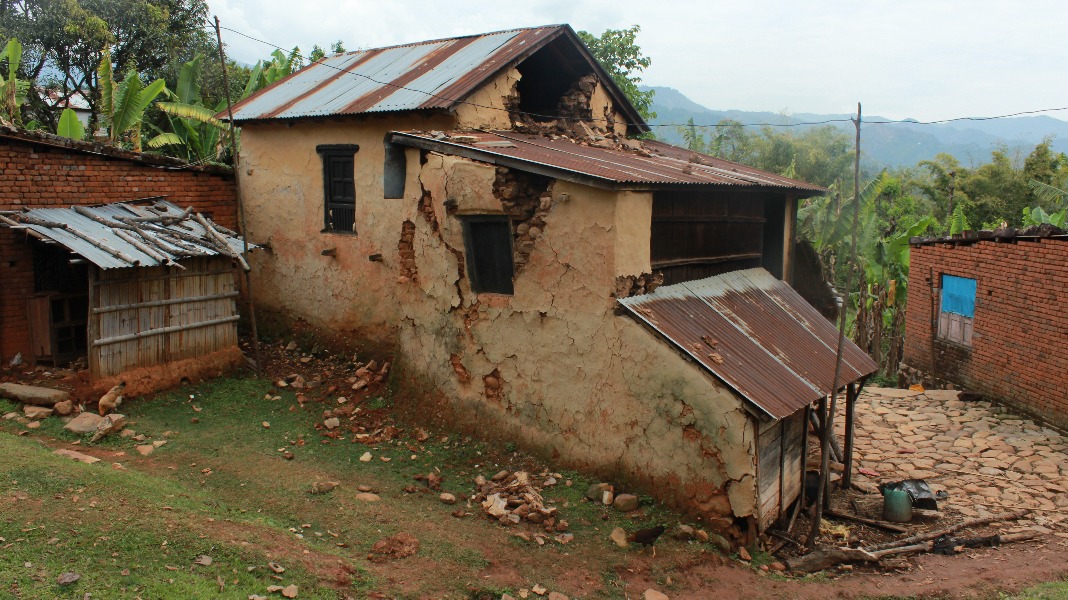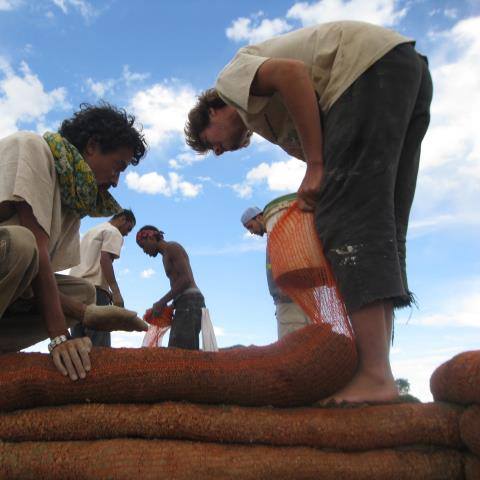
earthbag
Donation protected

 The situation in Nepal is dire. Although the media has turned its attention elsewhere, the Nepali people are still suffering from the devastation wrought by the 7.8 magnitude earthquake which struck Nepal on April 25th, and the subsequent aftershocks – one of which had a magnitude of 7.3. More than 8,600 were killed and over 23,000 were injured by the initial quake alone. According to Nepal’s National Emergency Operation Centre, at least 450,000 people have been displaced, and more houses crumble each day. “So many people around the world do not know there have been almost 200 quakes in Nepal in the last six weeks, all of them over 3.0 magnitude” -Bodhi Denton. Because the people of Nepal are now exposed to the elements, they are at a much higher risk for many diseases such as respiratory illness and hypothermia. It is impossible to fully comprehend what the people affected by this disaster are going through. Hundreds of thousands watched their homes crumble; parents lost children and children lost parents; thousands are left, not only homeless, but crippled as well. Some have received aid in the form of tents, water-purifying tablets, first aid and sanitation – but many have received no help whatsoever. With the monsoon season now upon them, flooding and landslides will exacerbate the suffering of the Nepali people. The government in Nepal is unable to respond adequately to the earthquakes: Nepal is classified as a least developed country, one of the poorest nations in the world, and is still recovering from a ten year civil war (yet to even draft a constitution). The people of Nepal need our compassion and assistance. n October, we – Justin Hall and Luke Trotman – will travel to Nepal to help lead a workshop on constructing superadobe earthbag domes. This will be a real and lasting solution for those who have lost their homes. Earthbag construction is a sustainable and minimalistic means of building resilient and efficient structures. Domes made of earthbags have proven repeatedly to be capable of withstanding strong earthquakes. Small Earth, a charity based out of the UK, built over forty domes for the Pegasus Children’s Project in the northern Kathmandu Valley in 2006. These domes serve as an orphanage for more than ninety children. After the quake, Small Earth founder, Julian Faulkner, is quoted, “The domes have come through relatively unscathed with just surface cracking to the plasterwork. In the village below the site 15 houses have collapsed and many others are badly damaged with all the villagers now sleeping under tarpaulins in the fields.”The resilient structure of the superadobe earthbag dome is achieved by combining the compressive strength of rammed earth and the tensile strength of repurposed barbed-wire in the self-buttressing format of the dome. The materials are easily accessible, and inexpensive and the building technique is simple, and quick to learn. The technology, created by Nadar Kalili and published by NASA, was donned the prestigious Aga Khan Award of Architecture in 2004. The earthbag approach to building is, both economically and structurally, the perfect solution for such a vulnerable part of the world. By teaching this technique to communities and leaving them with the materials to continue constructing new domes, this technology can be used to rebuild the lives of those who have lost so much. Within two months we want to build five ten-foot diameter domes for displaced families. Each dome will provide long term shelter to a family of four or more. We estimate that each dome will cost approximately $5,000. This estimate includes wages for a local workforce. Local residents involved with the building will learn to construct earthbag domes and be able to share this skill with their community. Because the quake hit right at the beginning of planting season, the sowing of annual seeds was greatly delayed. This delay has already begun to cause food shortages. Paying the local villagers to rebuild their homes will help families provide for their food needs in what could be a very difficult winter.We are working with our friends, Brandon Bodhi Denton and Michael Smith Brandon Bodhi Denton, of Permacultourism (a regenerative-tourism initiative of the Woven Earth Foundation adhering to the ethics of Permaculture: Earth Care, People Care, Fair Share). They have located a site in the Ghyampesal Region of Gorkha District, roughly eleven miles south of the epicenter of the April 25th earthquake. Gorkha District has been designated by Nepal’s government as one of the most affected areas.
The situation in Nepal is dire. Although the media has turned its attention elsewhere, the Nepali people are still suffering from the devastation wrought by the 7.8 magnitude earthquake which struck Nepal on April 25th, and the subsequent aftershocks – one of which had a magnitude of 7.3. More than 8,600 were killed and over 23,000 were injured by the initial quake alone. According to Nepal’s National Emergency Operation Centre, at least 450,000 people have been displaced, and more houses crumble each day. “So many people around the world do not know there have been almost 200 quakes in Nepal in the last six weeks, all of them over 3.0 magnitude” -Bodhi Denton. Because the people of Nepal are now exposed to the elements, they are at a much higher risk for many diseases such as respiratory illness and hypothermia. It is impossible to fully comprehend what the people affected by this disaster are going through. Hundreds of thousands watched their homes crumble; parents lost children and children lost parents; thousands are left, not only homeless, but crippled as well. Some have received aid in the form of tents, water-purifying tablets, first aid and sanitation – but many have received no help whatsoever. With the monsoon season now upon them, flooding and landslides will exacerbate the suffering of the Nepali people. The government in Nepal is unable to respond adequately to the earthquakes: Nepal is classified as a least developed country, one of the poorest nations in the world, and is still recovering from a ten year civil war (yet to even draft a constitution). The people of Nepal need our compassion and assistance. n October, we – Justin Hall and Luke Trotman – will travel to Nepal to help lead a workshop on constructing superadobe earthbag domes. This will be a real and lasting solution for those who have lost their homes. Earthbag construction is a sustainable and minimalistic means of building resilient and efficient structures. Domes made of earthbags have proven repeatedly to be capable of withstanding strong earthquakes. Small Earth, a charity based out of the UK, built over forty domes for the Pegasus Children’s Project in the northern Kathmandu Valley in 2006. These domes serve as an orphanage for more than ninety children. After the quake, Small Earth founder, Julian Faulkner, is quoted, “The domes have come through relatively unscathed with just surface cracking to the plasterwork. In the village below the site 15 houses have collapsed and many others are badly damaged with all the villagers now sleeping under tarpaulins in the fields.”The resilient structure of the superadobe earthbag dome is achieved by combining the compressive strength of rammed earth and the tensile strength of repurposed barbed-wire in the self-buttressing format of the dome. The materials are easily accessible, and inexpensive and the building technique is simple, and quick to learn. The technology, created by Nadar Kalili and published by NASA, was donned the prestigious Aga Khan Award of Architecture in 2004. The earthbag approach to building is, both economically and structurally, the perfect solution for such a vulnerable part of the world. By teaching this technique to communities and leaving them with the materials to continue constructing new domes, this technology can be used to rebuild the lives of those who have lost so much. Within two months we want to build five ten-foot diameter domes for displaced families. Each dome will provide long term shelter to a family of four or more. We estimate that each dome will cost approximately $5,000. This estimate includes wages for a local workforce. Local residents involved with the building will learn to construct earthbag domes and be able to share this skill with their community. Because the quake hit right at the beginning of planting season, the sowing of annual seeds was greatly delayed. This delay has already begun to cause food shortages. Paying the local villagers to rebuild their homes will help families provide for their food needs in what could be a very difficult winter.We are working with our friends, Brandon Bodhi Denton and Michael Smith Brandon Bodhi Denton, of Permacultourism (a regenerative-tourism initiative of the Woven Earth Foundation adhering to the ethics of Permaculture: Earth Care, People Care, Fair Share). They have located a site in the Ghyampesal Region of Gorkha District, roughly eleven miles south of the epicenter of the April 25th earthquake. Gorkha District has been designated by Nepal’s government as one of the most affected areas. There are many great organizations taking donations to help Nepal. Our project is very specific regarding where and how we will help. Many larger organization have overhead expenses such as paying directors, board members, etc. In contrast, all funds donated to this project will go directly to costs of building homes. Currently we are asking for donations mainly from our family and friends. Our goal is to raise $20,000 for this project. Please consider donating whatever amount feels good to you. Your kindness will make a difference in the lives of those who have lost the most from the earthquakes.
“We cannot change what has occurred, but we do have the choice of how to respond. We can always turn problems into opportunities if we use our creativity.“
目前尼泊爾的災後情況是很悲慘的,雖然媒體焦點已轉移他處,尼泊爾居民仍然因為4月25日發生規模7.8級的強震重擊及接續而來曾強達7.3級的餘震而飽受苦難摧殘,光是首次強震就已造成超過8,600人罹難,2萬3千人受傷,根據尼泊爾國家緊急行動中心(National Emergency Operation Centre)統計,超過45萬人被迫遷離家園且每天都有新的房屋倒塌,邦笛唐敦(Bondhi Denton)說:『世界上大多人都不知道尼泊爾在過去六週內發生了200次地震,全都是超過3級的有感地震』,由於尼泊爾居民現在正暴露在這樣的狀況中,他們得到呼吸道疾病和體溫過低等疾病症狀的機會也隨之明顯增加 。要完全了解這些人在這災難中所遭遇的苦難是不可能的,數十萬人親眼目睹自己的家園倒塌,父母親痛失孩子、孩子從此沒了父母,數千人頓時孤苦零丁,不僅是無家可歸,更喪失了自主生活能力,部分災民得到了帳篷、淨水劑、醫療急救、衛生設備類的援助 –然而,取多人根本沒有得到任何的援助,此刻伴隨著雨季而來的洪水和土石流更加深了尼泊爾居民的生活慘況,尼泊爾的政府沒有能力妥善處理此地震帶來的問題:尼泊爾被列為低度開發國家,也是全世界最貧窮國家之一,目前也還努力的從10年內戰帶來的民生潦苦中恢復(該國憲法尚未制定完成),尼泊爾的人民需要我們的憐憫心和救援。我們是賈斯丁(Justin Hall)和路可(Luke Trotman),將會在十月的時候前往尼泊爾去協助帶領一個超級簡易土袋屋建築工作坊,這將會是那些失去家園的災民們一個實際且長久的解決困境方法,土袋屋是一種既永續又極簡,兼顧防震及實用性的建築方式,以土壤袋搭疊建造而成的土袋屋已被多次證實能抵擋地震的侵襲,2006年一個總部位於英國外的慈善團體,小地球(Small Earth),替北加德滿都谷地的Pegasus孩童計畫搭建了超過40座土袋屋,這些土屋成為90多名孤兒可以休息的孤兒院,在地震之後,小地球的創辦人,朱利安 佛克楠(Julian Faulkner)說:『這些土屋撐過了地震,除了表面圖層有些許的裂縫外沒什麼大礙,在同一個村子裡,有15間房子不幸倒塌,更有許多房子破損嚴重,許多村民現在都只能睡在空地上搭建的防水布下。』超級簡易土袋屋的防震性主要來自於填實重壓過的土壤袋的支撐力和土屋拱壁外層構造中有刺鐵絲網帶來的可伸展性,所需要的材料非常容易取得且價格低,不需要很高深的建築技術所以一般人很容易學會,這個技術由建築師Nadar Kalili發明,並由美國太空總署(NASA)公開發表,在2004年贏得極具聲望的阿卡罕建築獎,在經濟和技術考量上,這種土袋建築是因應地球上這一塊脆弱地表特性最佳的處理方法,藉由教導地方社區這種建築技術並留給他們建蓋材料讓他們得以繼續重建新的家園,也讓失去一切的人得以有機會重新開始生活。我們目前正與璞門文化觀光社(Permacultourism,一個由織世基金會(Woven Earth Foundation)參照璞門文化精神所推創的一種革新旅遊風格:守護地球、關愛人類、公平分享)的好友們,布蘭登(Brandon Bodhi Denton)和麥可史密斯(Michael Smith)合作,他們在廓爾喀區(Gorkha)的Ghyampesal設置了一個辦公室,離4月25日發生的強震震央約18公里遠, 廓爾喀區也是尼泊爾政府公佈遭到地震影響最深的地區之一。我們希望在兩個月內能搭建5座直徑約6.7公尺大小的土袋屋給受難家庭使用,每一個土屋將能提供一家四口以上的家庭一個長期庇護空間,我們預計每座土屋需花費$5,000美元,這預估的費用包含當地人民勞動的薪資,當地居民學習這項建築技巧後,可以重蓋自己家園,還可以教導並協助其他居民如何使用此技術重建生活,此外,由於這場地震正好發生在播種季之前,因此年度耕種步調嚴重地拖延,這已開始造成食物短缺的現象,支付工錢給當地村民讓他們得以在重建家園的過程中有所收入,進而幫助他們度過一個已預期可見的困苦寒冬。
非常多的組織正在募集資金要以救助尼泊爾,相較之下,我們的計劃有非常明確的救助項目和協助方法,許多大型組織需要承擔許多額外花費,如支付執行者或基金會董事薪水等,相反的,此計畫募得的所有捐款將會全數直接用在土袋屋建設上,目前而言,我們只能透過親朋好友的捐款來籌募資金,目標是為這個計畫募得2萬美元,我們誠摯地邀請您透過捐獻的方式和我們一起努力,任何您覺得合適的金額都是一種幫助,您的愛心將會成為這次在地震中失去最多的人對未來的希望之苗。
『我們不能改變已經發生的事,但是我們擁有如何面對的選擇,如果運用我們的創造力,我們總是能將問題轉化為機會』- Brandon Bodhi Denton
目前尼泊尔的灾后情况是很惨烈的,虽然媒体焦点已转移他处,尼泊尔居民仍然因为4月25日发生规模7.8级的强震重击及接续而来曾强达7.3级的余震而饱受苦难摧残,光是首次强震就已造成超过8,600人罹难,2万3千人受伤,根据尼泊尔国家紧急行动中心(National Emergency Operation Centre)统计,超过45万人被迫迁离家园且每天都有新的房屋倒塌,邦笛唐敦(Bondhi Denton)说:『世界上大多人都不知道尼泊尔在过去六周内发生了200次地震,全都是超过3级的有感地震』,由于尼泊尔居民现在正暴露在这样的状况中,他们得到呼吸道疾病和体温过低等疾病症状的机会也随之明显增加。要完全了解这些人在这灾难中所遭遇的苦难是不可能的,数十万人亲眼目睹自己的家园倒塌,父母亲痛失孩子、孩子从此没了父母,数千人顿时孤苦零丁,不仅是无家可归,更丧失了自主生活能力,部分灾民得到了帐篷、净水剂、医疗急救、卫生设备类的援助–然而,取多人根本没有得到任何的援助,此刻伴随着雨季而来的洪水和土石流更加深了尼泊尔居民的生活惨况,尼泊尔的政府没有能力妥善处理此地震带来的问题:尼泊尔被列为低度开发国家,也是全世界最贫穷国家之一,目前也还努力的从10年内战带来的民生潦苦中恢复(该国宪法尚未制定完成),尼泊尔的人民需要我们的怜悯心和救援。我们是贾斯丁(Justin Hall)和路可(Luke Trotman),将会在十月的时候前往尼泊尔去协助带领一个超级简易土袋屋建筑工作坊,这将会是那些失去家园的灾民们一个实际且长久的解决困境方法,土袋屋是一种既永续又极简,兼顾防震及实用性的建筑方式,以土壤袋搭叠建造而成的土袋屋已被多次证实能抵挡地震的侵袭,2006年一个总部位于英国外的慈善团体,小地球(Small Earth),替北加德满都谷地的Pegasus孩童计画搭建了超过40座土袋屋,这些土屋成为90多名孤儿可以休息的孤儿院,在地震之后,小地球的创办人,朱利安佛克楠(Julian Faulkner)说:『这些土屋撑过了地震,除了表面图层有些许的裂缝外没什么大碍,在同一个村子里,有15间房子不幸倒塌,更有许多房子破损严重,许多村民现在都只能睡在空地上搭建的防水布下。 』超级简易土袋屋的防震性主要来自于填实重压过的土壤袋的支撑力和土屋拱壁外层构造中有刺铁丝网带来的可伸展性,所需要的材料非常容易取得且价格低,不需要很高深的建筑技术所以一般人很容易学会,这个技术由建筑师Nadar Kalili发明,并由美国太空总署(NASA)公开发表,在2004年赢得极具声望的阿卡罕建筑奖,在经济和技术考量上,这种土袋建筑是因应地球上这一块脆弱地表特性最佳的处理方法,藉由教导地方社区这种建筑技术并留给他们建盖材料让他们得以继续重建新的家园,也让失去一切的人得以有机会重新开始生活。我们目前正与璞门文化观光社(Permacultourism,一个由织世基金会(Woven Earth Foundation)参照璞门文化精神所推创的一种革新旅游风格:守护地球、关爱人类、公平分享)的好友们,布兰登(Brandon Bodhi Denton)和麦可史密斯(Michael Smith)合作,他们在廓尔喀区(Gorkha)的Ghyampesal设置了一个办公室,离4月25日发生的强震震央约18公里远, 廓尔喀区也是尼泊尔政府公布遭到地震影响最深的地区之一。我们希望在两个月内能搭建5座直径约6.7公尺大小的土袋屋给受难家庭使用,每一个土屋将能提供一家四口以上的家庭一个长期庇护空间,我们预计每座土屋需花费$5,000美元,这预估的费用包含当地人民劳动的薪资,当地居民学习这项建筑技巧后,可以重盖自己家园,还可以教导并协助其他居民如何使用此技术重建生活,此外,由于这场地震正好发生在播种季之前,因此年度耕种步调严重地拖延,这已开始造成食物短缺的现象,支付工钱给当地村民让他们得以在重建家园的过程中有所收入,进而帮助他们度过一个已预期可见的困苦寒冬。
非常多的组织正在募集资金要以救助尼泊尔,相较之下,我们的计划有非常明确的救助项目和协助方法,许多大型组织需要承担许多额外花费,如支付执行者或基金会董事薪水等,相反的,此计画募得的所有捐款将会全数直接用在土袋屋建设上,目前而言,我们只能透过亲朋好友的捐款来筹募资金,目标是为这个计画募得2万美元,我们诚挚地邀请您透过捐献的方式和我们一起努力,任何您觉得合适的金额都是一种帮助,您的爱心将会成为这次在地震中失去最多的人对未来的希望之苗。
『我们不能改变已经发生的事,但是我们拥有如何面对的选择,如果运用我们的创造力,我们总是能将问题转化为机会』- Brandon Bodhi Denton。
For more information, visit these links:
/ http://www.permacultourism.com/details/
Pegasus Children's Project
http://www.akdn.org/architecture/pdf/2761_Ira.pdf" target="_blank">Sandbag Shelter Prototypes in Various Locations
Responding with Unity to Build Resilience - Brandon Bodhi Denton
Cal-Earth: Emergency Sandbag Shelters
Aga Khan Award for Architecture
Emergency Sandbag Shelter Training Guide
Organizer
Luke Trotman
Organizer
Asheville, NC